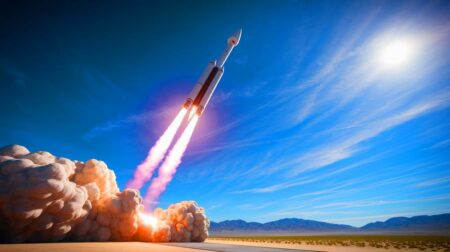| IN A NUTSHELL |
|
The recent announcement of a collaborative effort between China and Russia to construct a nuclear reactor on the Moon marks a significant advancement in space exploration. This initiative aims to power a permanent base at the Moon’s south pole by 2035. As the world turns its eyes to the skies, the implications of such a project reach far beyond scientific achievement, impacting global geopolitics and technological innovation. The ambitious timeline set by China and Russia underscores the urgent need for sustainable energy solutions in space exploration and positions them as key players in the new space race.
China and Russia’s Bold Lunar Ambitions
China’s plan to build a nuclear power plant on the Moon, in collaboration with Russia, highlights their growing influence in space exploration. This endeavor, spearheaded by Pei Zhaoyu, chief engineer of the Chang’e-8 mission, aims to power the International Lunar Research Station (ILRS). The Chang’e-8 mission, scheduled for launch in 2028, is a cornerstone of China’s space ambitions, paving the way for a permanently staffed lunar base by 2030.
The ILRS will require a reliable energy source to withstand the Moon’s harsh environment. Nuclear power emerges as a strong contender due to its long-term sustainability. Russia’s expertise in space-based nuclear technology is a critical asset, given its history of success in deploying nuclear power plants in space. Although China has not officially confirmed its commitment to the reactor, Pei’s presentation to officials from 17 countries suggests strong backing from Beijing.
NASA’s Artemis Program Sparks Competition
As China and Russia advance their lunar ambitions, the United States is reviving its lunar exploration efforts through NASA’s Artemis program. With plans to land two astronauts on the Moon by 2027 and build a sustainable base, NASA is exploring various energy solutions, including large solar arrays and nuclear power. This program reflects America’s determination to reclaim its leadership in space, having not returned to the Moon since 1972.
China and Russia’s timeline for developing the ILRS aligns closely with NASA’s plans. Wu Weiren, chief designer of China’s lunar exploration program, stated that a basic model of the ILRS would be completed by 2035. The “555 Project” further exemplifies China’s commitment to international collaboration, inviting participation from 50 countries, 500 scientific institutions, and 5,000 researchers worldwide.
A New Era of Space Resources and Nuclear Innovation
China’s rapid ascent in the space arena over the past two decades is remarkable. From launching its first astronaut in 2003 to landing a rover on Mars, China is now poised to build a nuclear power plant on the Moon. This move could redefine space exploration, enabling large-scale operations like energy generation and cargo transport.
The Moon’s natural resources are a significant motivator for establishing a presence there. It holds valuable metal oxides, silicon, titanium, rare Earth metals, and aluminum deposits. The potential of helium-3, a rare isotope, adds to the allure, with Chinese scientists suggesting it could meet global energy demands for thousands of years. Such resources could revolutionize energy production on Earth and beyond.
Implications for Global Geopolitics
The collaboration between China and Russia on the lunar reactor project has far-reaching geopolitical implications. As these nations strengthen their ties in space, questions arise about the balance of power in international space exploration. The lunar base project could potentially lead to the creation of new alliances and partnerships, reshaping the landscape of global geopolitics.
Moreover, the competition for lunar resources and technological supremacy is likely to intensify. The United States and its allies will need to reconsider their strategies to maintain influence in space. This development could lead to increased investments in space technology and a renewed focus on international cooperation to avoid conflicts over lunar resources.
As China and Russia embark on this ambitious journey to build a nuclear reactor on the Moon, the world watches with bated breath. Their efforts could redefine the future of space exploration and energy production. With the potential for new alliances and partnerships, how will these developments shape the future of international collaboration in space exploration?
Did you like it? 4.5/5 (29)









Wow, China and Russia are really reaching for the stars! 🚀